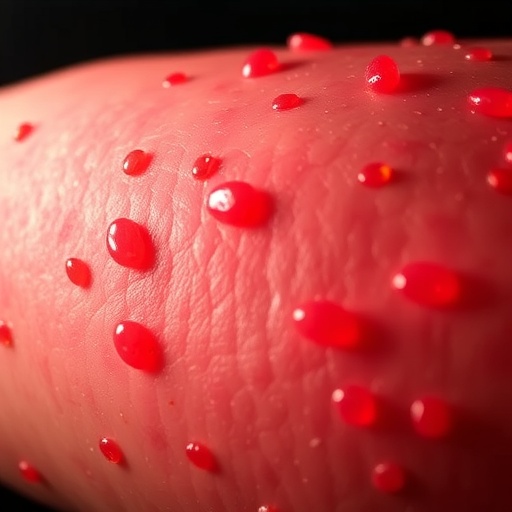
Recent advancements in understanding macrophage biology have unveiled a crucial link between these immune cells and the complexities of dermatological conditions, particularly those arising from radiation exposure. A pivotal study conducted by Chugh et al. investigates the role of macrophage-derived Vascular Endothelial Growth Factor (VEGF) in regulating macrophage senescence and its subsequent impact on inhibiting radiation-induced dermatitis. This groundbreaking research sheds light on the underlying mechanisms driving skin responses to radiation, providing a promising avenue for therapeutic interventions.
The study, published in the Journal of Translational Medicine, presents a multifaceted analysis that reveals how macrophage-derived VEGF can modulate cellular aging processes. Macrophages are integral components of the immune system, known for their ability to adapt and respond to various stimuli. Their role in inflammation, tissue repair, and regulation of other immune cells makes them a focal point in understanding dermatological diseases linked to radiation.
One of the central findings of the research is the intricate relationship between macrophage senescence and the overall inflammatory response in irradiated tissues. As tissues undergo radiation exposure, there is a cascade of cellular events that lead not only to direct cellular damage but also to the activation of immune responses. The aging of macrophages, characterized by functional decline and altered secretory profiles, can significantly influence the healing process in the skin. By regulating this senescence, the researchers identified a potential mechanism through which skin integrity can be preserved, ultimately leading to reduced dermatitis incidence.
VEGF is typically known for its pivotal role in angiogenesis, the process through which new blood vessels form from pre-existing ones. However, its implications extend beyond vascular biology. In the context of macrophage function, VEGF influences not only the migration and activation of these cells but also their lifespan and functional capacities. The study postulates that macrophage-derived VEGF serves as a critical factor that can modulate the senescence of these immune cells, with potential ramifications for tissue health following radiation exposure.
The research methodology is particularly noteworthy, involving a combination of in vitro experiments and in vivo models. The team utilized advanced imaging techniques and molecular analyses to trace the dynamics of macrophage behaviors under radiation exposure. By assessing markers of cellular senescence and inflammatory pathways, they could elucidate how VEGF secretion modifies the macrophage response and promotes a more effective healing environment.
One intriguing aspect of the study is how VEGF influences the specific phenotypic changes in macrophages during senescence. The macrophages that were derived from irradiated tissues expressed higher levels of VEGF, suggesting a positive feedback loop where radiation exposure not only triggers macrophage activation but simultaneously alters their aging process. This discovery brings forth essential implications for developing strategies aimed at mitigating radiation-induced injuries, particularly in clinical settings such as cancer therapy, where radiotherapy is a common treatment modality.
The translational potential of this research cannot be overstated. If the mechanisms elucidated by Chugh et al. can be harnessed therapeutically, it could lead to innovative treatments that improve patient outcomes following radiation therapy. For instance, targeting the signaling pathways associated with VEGF might enhance macrophage functions that promote tissue repair, thus minimizing the adverse effects of radiation on the skin.
Furthermore, exploring the broader implications of this research opens the door to potential applications beyond radiation-induced dermatitis. The role of macrophages in various inflammatory skin conditions, such as psoriasis or atopic dermatitis, suggests that further investigation into VEGF signaling could also yield new therapeutic targets for these diseases, which remain challenging to manage effectively.
As we look to the future, continued research is vital to deepen our understanding of the complexities surrounding macrophage biology and their role in tissue homeostasis. Investigating the intersection of immune responses, tissue repair, and cellular aging will be critical in developing strategies to improve outcomes in dermatological health. The critical findings from Chugh et al. provide a robust framework for further exploration of macrophage-derived factors in skin biology, emphasizing the necessity of interdisciplinary approaches to overcome the barriers faced in treating radiation-induced and other inflammatory skin conditions.
In conclusion, the study by Chugh and colleagues presents a significant advancement in the field of dermatological research by unraveling the role of macrophage-derived VEGF in regulating macrophage senescence. The implications of these findings could lead to novel therapeutic strategies that address radiation-induced dermatitis, transforming the landscape of treatment options for patients undergoing radiotherapy. As the field continues to evolve, the insights gained from this work will undoubtedly inspire further investigations aimed at harnessing the power of the immune system to promote skin health.
Understanding the relationship between macrophages and their surrounding microenvironment remains a key challenge in immunology and dermatology. Going forward, it will be essential to establish how different cytokines and growth factors interact in various contexts to either enhance or inhibit the healing processes in skin. Additionally, deciphering the pharmacological modulation of macrophage functions presents a rich area for future research that could lead to significant improvements in patient care.
Amidst the promise shown by macrophage-derived VEGF, there are also potential challenges that need to be addressed. One such challenge is the need to delineate the contexts in which VEGF might have beneficial versus detrimental effects. Given its notable role in angiogenesis, the dynamic behavior of VEGF in different tissue environments warrants careful consideration when designing potential therapeutic interventions. Future studies must aim to profile macrophage responses in diverse pathological settings to identify key determinants of efficacy.
In summary, the study highlights the multifactorial nature of skin health and disease and the essential role immune cells play in determining outcomes after radiation exposure. By focusing on regulatory mechanisms related to macrophage senescence and VEGF, researchers can pave the way for novel preventative and therapeutic strategies that improve skin resilience and healing. The endeavor to enhance our understanding of macrophage biology in the context of dermatology is an exciting frontier that holds significant promise for the future of patient care in radiation-associated skin conditions.
Subject of Research: The regulatory role of macrophage-derived VEGF in macrophage senescence and its effects on radiation-induced dermatitis.
Article Title: Macrophage derived VEGF regulates macrophage senescence to inhibit radiation-induced dermatitis.
Article References:
Chugh, R.M., Gupta-Saraf, P., Bhanja, P. et al. Macrophage derived VEGF regulates macrophage senescence to inhibit radiation-induced dermatitis.
J Transl Med 23, 985 (2025). https://doi.org/10.1186/s12967-025-07016-x
Image Credits: AI Generated
DOI: 10.1186/s12967-025-07016-x
Keywords: Macrophages, VEGF, senescence, radiation-induced dermatitis, inflammation, tissue repair, immunology, dermatology.
Tags: cellular aging and skin responsedermatological conditions linked to radiationimmune response to radiation exposureimmune system and dermatological diseasesJournal of Translational Medicine studymacrophage senescence and inflammationmacrophage-derived VEGFmechanisms of radiation damage in skinradiation-induced dermatitis treatmentrole of macrophages in tissue repairtherapeutic interventions for radiation injuriesVascular Endothelial Growth Factor in skin health




